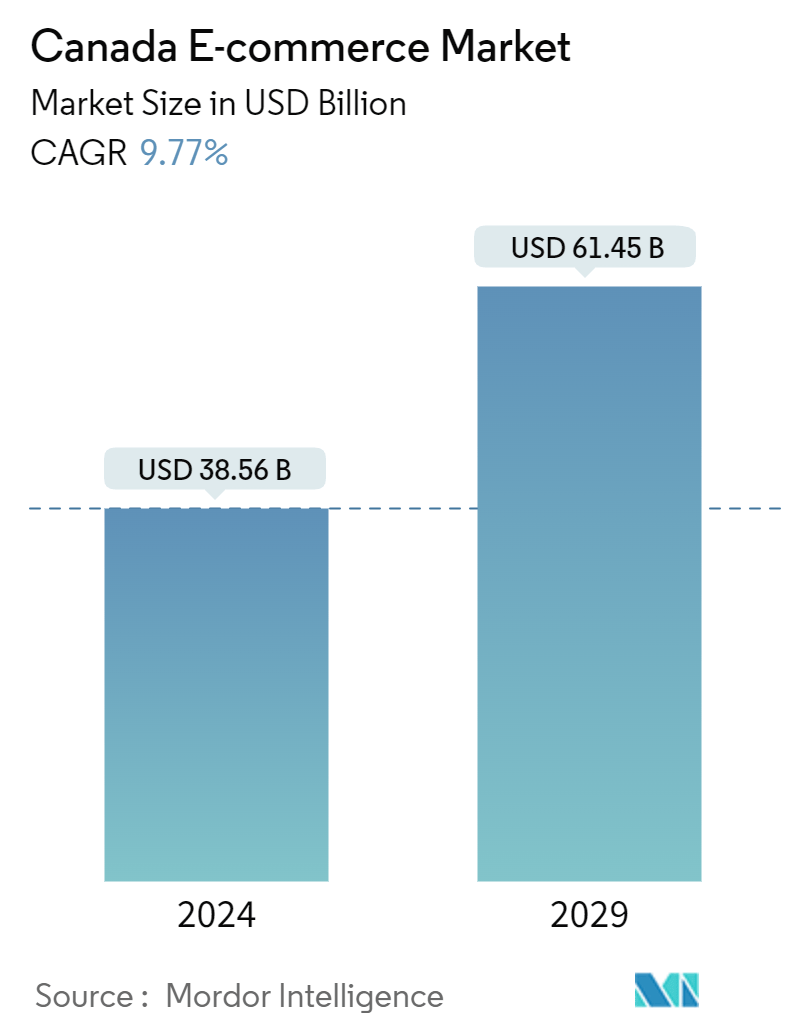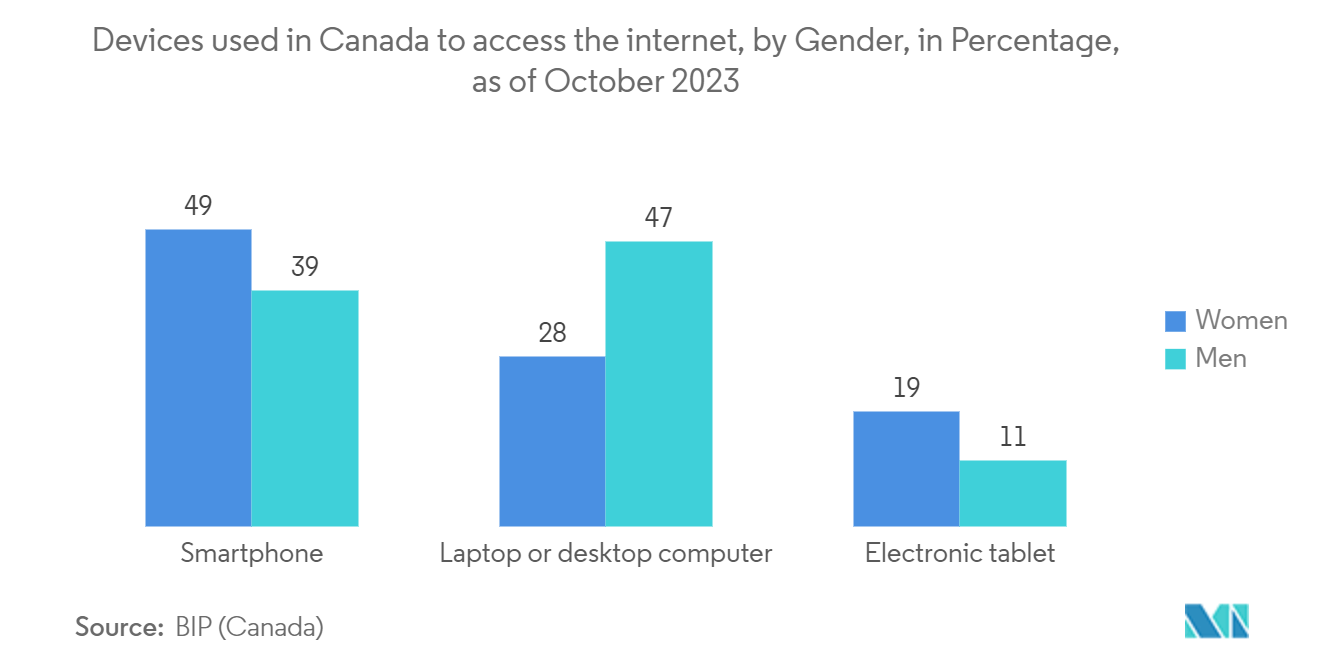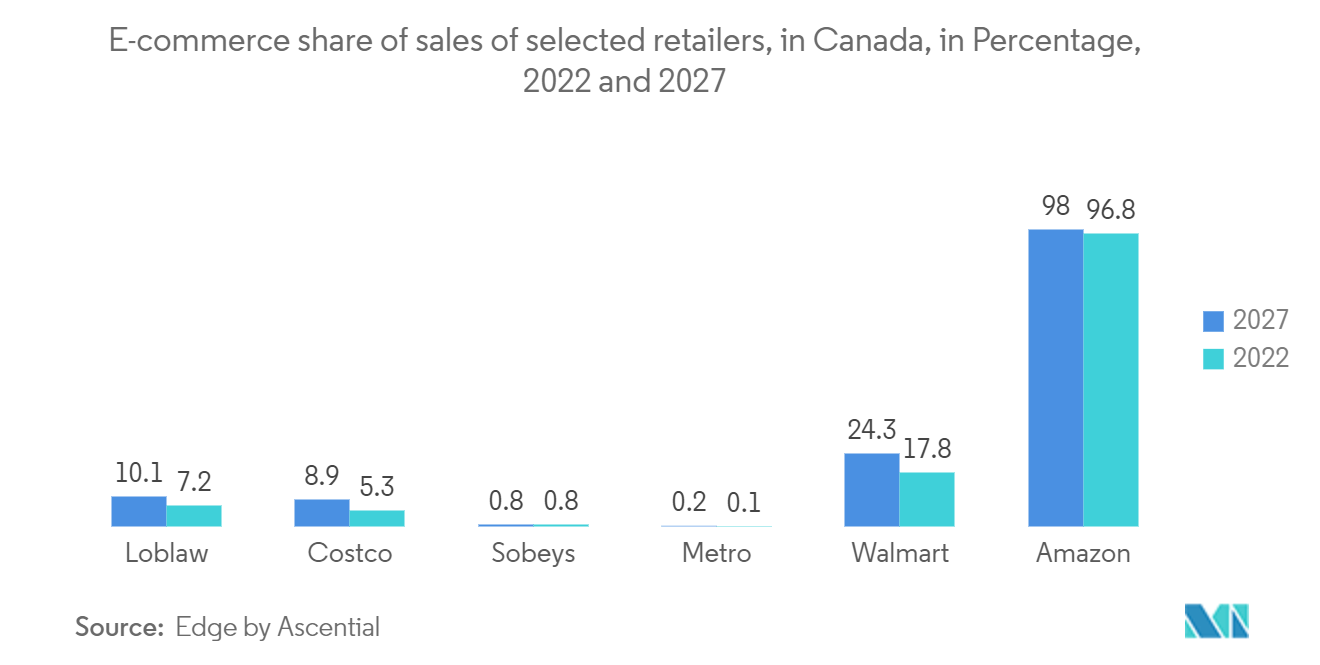Canada E-commerce Market Size

| Study Period | 2019 - 2029 |
| Base Year For Estimation | 2023 |
| Market Size (2024) | USD 38.56 Billion |
| Market Size (2029) | USD 61.45 Billion |
| CAGR (2024 - 2029) | 9.77 % |
| Market Concentration | Medium |
Major Players
*Disclaimer: Major Players sorted in no particular order |
Canada E-commerce Market Analysis
The Canada E-commerce Market size is estimated at USD 38.56 billion in 2024, and is expected to reach USD 61.45 billion by 2029, growing at a CAGR of 9.77% during the forecast period (2024-2029).
- The e-commerce market in Canada is growing significantly, driven by the high Internet and mobile penetration, changing consumer behavior, and secure and diverse payment options. The Canadian consumer landscape is characterized by high internet penetration and a growing preference for online shopping. Over 90% of Canadians have access to the Internet, and a significant portion of this population engages in online shopping.
- Canadian consumers appreciate the convenience, variety, and competitive pricing offered by e-commerce platforms. Additionally, mobile commerce is rising in Canada, with more consumers using smartphones and tablets for shopping. According to the report by BIP (Canada), smartphone use for the Internet reached 44% in 2023. This trend underscored the importance of mobile-optimized websites and apps for retailers.
- Further, with a large percentage of the population connected to the Internet, the potential customer base for online retailers is substantial. The widespread use of smartphones further enhances the accessibility and convenience of online shopping. Also, efficient logistics and delivery networks, including same-day and next-day delivery options, play a crucial role in enhancing the e-commerce experience. Companies like Canada Post and Purolator have expanded their capacities to meet the growing demand.
- In Canada, many physical retailers have expanded their online presence, integrating e-commerce into their business models. This omnichannel approach allows retailers to reach a broader audience and offer a seamless shopping experience. Also, the rising middle class and increasing disposable income levels in Canada have fueled demand for consumer electronics products such as smartphones, laptops, tablets, and smart home devices. As consumers become more tech-savvy and aspire to upgrade their lifestyles with the latest gadgets, they increasingly turn to e-commerce platforms for their purchases.
- The e-commerce landscape in Canada is poised for further growth in the coming years. As technology advances and consumer tastes evolve, e-commerce firms are under pressure to adapt swiftly and innovate to retain their competitive edge. Prioritizing customer experience, integrating cutting-edge technologies, and tackling logistical hurdles are imperative strategies for driving sustained growth in this ever-evolving market.
Canada E-commerce Market Trends
The Number of Internet Users is Increasing in Canada
- Canadian consumers are increasingly relying on the Internet for purchases, with online sales outpacing traditional retail transactions in recent years. Most retail businesses in Canada have integrated internet-based platforms, often incorporating wireless technologies, to bolster their interactions with companies and consumers. Moreover, manufacturing entities and governmental bodies are shifting to the Internet for procurement, particularly for smaller, regular orders. Around 94.3% of Canadians in 2023 had consistent internet access.
- Internet access provides an essential link to the rest of the world for residents in remote communities in Northern Canada, but delivering high-speed services remains costly and complex. According to reports published by the International Trade Administration in 2023, in 2022, Canada boasted a staggering 27 million e-commerce users, representing 75% of the nation's population. Projections indicate this figure is set to climb to 77.6% by 2025. This growing inclination toward e-commerce is driving the overall market.
- The Canadian e-commerce market is similar to that of the United States, and it shares some of the same trends as retailers in the South. Hybrid purchases, such as "click and collect" and "omnichannel," where consumers order products online and pick them up from a brick-and-mortar store, are shaping the Canadian e-commerce market. The Canadian e-commerce market involves social media usage because the return on investment by using social media is constantly improving, and retailers are increasingly spending significantly on social media ads.
- In Canada, there are several payment methods in internet shopping, the most common of which are credit card-based, such as Interac Online, MasterPass, and PayPal. Some vendors also offer the option of prepaid cards or prepaid vouchers. Also, in terms of consumer preferences, young Canadians are more willing to make mobile purchases and are more receptive to mobile advertisements. As per the report by BIP (Canada), a smartphone is the most used device for internet access in Canada among people. Around 49% of women and 39% of men use smartphones to access the Internet.
- Video advertising is also preferred in Canada. According to Com Score, mobile commerce (m-commerce) is rising, owing to the increasing mobile connectivity of smartphones and tablets. Digital advertising surpassed TV advertising revenues and is poised to become Canada's preferred advertising medium.

The B2C E-commerce Segment is Growing
- The business-to-consumer e-commerce market in Canada has experienced significant growth over recent years. The market is witnessing significant shifts and expansions as more Canadians turn to online shopping for convenience, variety, and competitive pricing.
- Canada's B2C e-commerce market has seen a rapid increase in online shoppers and the overall sales volume. According to Statistics Canada, e-commerce sales are continuously growing in the country. This surge is expected to be sustained in the coming years as consumers become accustomed to the convenience of online shopping. The electronics segment is the leading product category, followed by fashion and furniture. Around 59% of Canadian shoppers use credit cards online, and 20% use PayPal. Digital wallets are steadily increasing and are estimated to account for 27% of online payments by 2025.
- The growth of e-commerce can be attributed to the volume of purchases and the amount of goods and services Canadians purchase. The largest share of goods purchased by Canadians from US merchants include apparel and accessories, followed by books, music, and videos, consumer electronics, toys, hobbies, and games, health and beauty products, footwear, jewelry, household goods, sporting goods, DIY and garden supplies, and groceries.
- There are several companies in the market catering to the B2C segment. Of these, Amazon is expected to generate 98% of its sales in Canada through e-commerce channels in 2027, an increase from 96.8% in 2022. Such increasing sales indicate the growth of e-commerce retailers in Canada. The market is expected to continue to grow over the coming years.

Canada E-commerce Industry Segmentation
The Canadian e-commerce market is semi-concentrated and dominated by major players like Walmart, Amazon, Costco Canada, Home Depot Canada, and Target. With a prominent market share, these major players focus on expanding their customer base across the country.
- March 2024: Target Corporation unveiled plans to enhance its guest experience and bolster long-term growth. The plans focus on innovation and expanding its owned brand portfolio, valued at over USD 30 billion, by introducing new, trend-setting products emphasizing quality and value. Additionally, the company is set to roll out a revamped loyalty program featuring three membership tiers, one free to join, empowering guests to tailor their shopping and savings experiences.
Canada E-commerce Market Leaders
-
Amazon Canada
-
Walmart Canada
-
Costco Canada
-
Home Depot Canada
-
Apple
*Disclaimer: Major Players sorted in no particular order

Canada E-commerce Market News
- July 2024: Wayfair announced a clearance sale in Canada. Through this sale, the company offered deals with up to 70% off on products used in bedrooms, home offices, or storage and organization. These included new sofas, coffee tables, tableware, décor, and lighting.
- March 2024: Amazon announced the launch of a new Big Spring Sale in Canada. This sale promoted seasonal items in Canada. Under this sale, Amazon customers would be able to select from a range of products, including Echo and Kindle devices. Prime members would enjoy exclusive deals.
Canada Ecommerce Market Report - Table of Contents
1. INTRODUCTION
- 1.1 Study Assumptions and Market Definitions
- 1.2 Scope of the Study
2. RESEARCH METHODOLOGY
3. EXECUTIVE SUMMARY
4. MARKET INSIGHTS
- 4.1 Market Overview
-
4.2 Industry Attractiveness-Porter's Five Forces Analysis
- 4.2.1 Bargaining Power of Suppliers
- 4.2.2 Bargaining Power of Buyers/Consumers
- 4.2.3 Threat of New Entrants
- 4.2.4 Threat of Substitute Products
- 4.2.5 Intensity of Competitive Rivalry
- 4.3 Key market trends and share of E-commerce of total Retail sector
- 4.4 Impact of COVID-19 on the E-commerce sales
5. MARKET DYNAMICS
-
5.1 Market Drivers
- 5.1.1 Growing Contactless Forms of Payment
- 5.1.2 Rise in Cross-Border Online Shopping
- 5.1.3 Penetration of Internet and Smartphone Usage
-
5.2 Market Challenges
- 5.2.1 High Cost of Internet
- 5.2.2 Security Issues
- 5.3 Analysis of key demographic trends and patterns related to E-commerce industry in Canada (Coverage to include Population, Internet Penetration, E-commerce Penetration, Age & Income etc.)
- 5.4 Analysis of the key modes of transaction in the E-commerce industry in Canada (coverage to include prevalent modes of payment such as cash, card, bank transfer, wallets, etc.)
- 5.5 Analysis of cross-border E-commerce industry in Canada (Current market value of cross-border & key trends)
- 5.6 Current positioning of country Canada in the E-commerce industry in region North America
6. Market Segmentation
-
6.1 By B2C E-commerce
- 6.1.1 Market size (GMV) for the period of 2017-2027
- 6.1.2 Market Segmentation - by Application
- 6.1.2.1 Beauty & Personal Care
- 6.1.2.2 Consumer Electronics
- 6.1.2.3 Fashion & Apparel
- 6.1.2.4 Food & Beverage
- 6.1.2.5 Furniture & Home
- 6.1.2.6 Others (Toys, DIY, Media, etc.)
-
6.2 By B2B E-commerce
- 6.2.1 Market size for the period of 2017-2027
7. Competitive Landscape
-
7.1 Company Profiles*
- 7.1.1 Walmart
- 7.1.2 Amazon
- 7.1.3 Zara
- 7.1.4 Home Depot
- 7.1.5 Target
- 7.1.6 Apple
- 7.1.7 Costco
- 7.1.8 Kroger
- 7.1.9 Best Buy
- 7.1.10 Wayfair
8. Investment Analysis
9. Future Outlook of the Market
** Subject To AvailablityCanada E-commerce Industry Segmentation
E-commerce is the buying and selling of goods and services over the Internet through online shopping. However, this term is often used to describe a seller's efforts in selling products directly to consumers. It begins when potential customers learn about a product, buy it, use it, and ideally maintain lasting customer loyalty. The report's scope includes market sizes and forecasts for B2B and B2C e-commerce.
The Canada e-commerce market is segmented by B2C e-commerce (beauty and personal care, consumer electronics, fashion and apparel, food and beverage, and furniture and home) and B2B e-commerce. The market sizes and forecasts are provided in terms of value (USD) for all the above segments.
| By B2C E-commerce | Market size (GMV) for the period of 2017-2027 | |
| Market Segmentation - by Application | Beauty & Personal Care | |
| Consumer Electronics | ||
| Fashion & Apparel | ||
| Food & Beverage | ||
| Furniture & Home | ||
| Others (Toys, DIY, Media, etc.) | ||
| By B2B E-commerce | Market size for the period of 2017-2027 |
Canada Ecommerce Market Research FAQs
How big is the Canada E-commerce Market?
The Canada E-commerce Market size is expected to reach USD 38.56 billion in 2024 and grow at a CAGR of 9.77% to reach USD 61.45 billion by 2029.
What is the current Canada E-commerce Market size?
In 2024, the Canada E-commerce Market size is expected to reach USD 38.56 billion.
Who are the key players in Canada E-commerce Market?
Amazon Canada, Walmart Canada, Costco Canada, Home Depot Canada and Apple are the major companies operating in the Canada E-commerce Market.
What years does this Canada E-commerce Market cover, and what was the market size in 2023?
In 2023, the Canada E-commerce Market size was estimated at USD 34.79 billion. The report covers the Canada E-commerce Market historical market size for years: 2019, 2020, 2021, 2022 and 2023. The report also forecasts the Canada E-commerce Market size for years: 2024, 2025, 2026, 2027, 2028 and 2029.
What are the key drivers of growth in Canada's E-Commerce Sector?
The Canada Ecommerce Market growth is driven by: a) High internet penetration b) Widespread use of smartphones c) Changing consumer behaviors d) Convenience of online shopping
What are the key drivers of growth in Canada's E-Commerce Sector?
The Canada Ecommerce Market growth is driven by: a) High internet penetration b) Widespread use of smartphones c) Changing consumer behaviors d) Convenience of online shopping
Ecommerce in Canada Industry Report
The Canada E-Commerce Market Report is segmented by B2C E-Commerce and B2B E-Commerce. The Canadian e-commerce landscape is undergoing significant transformation, driven by technological advancements and evolving market dynamics. With more Canadians turning to online shopping, fueled by the widespread adoption of mobile devices and increasing internet penetration, e-commerce in Canada is set for substantial growth. The market is adapting to consumer demands for personalized shopping experiences and leveraging social media to engage with audiences. Despite challenges like high shipping costs, the Canadian e-commerce sector offers opportunities for expansion and technological investment to enhance the shopping experience. Popular categories include fashion, electronics, and home goods, with the market segmented by product categories, demographics, and regions. Businesses are encouraged to improve customer experiences and explore partnerships in this dynamic environment.
The industry growth is evident in the market size and the growth rate. The industry statistics reveal significant insights into the market value and market share. The growth statistics and market research highlight the potential for market growth. The industry report and report pdf provide a comprehensive analysis of the market structure and market segmentation. The sector analysis and analysis report delve into the industry analysis and industry size. The market analysis and industry worth offer detailed information on the market overview and market outlook.
The market data and sales forecast indicate positive trends in the industry outlook. The market report and market value emphasize the importance of understanding market segmentation. The industry overview and growth forecast provide a clear picture of the target market. The industry profile and industry value highlight the significance of market statistics. The industry pdf and market forecast give insights into the market leaders and market review. The market overview and revenue statistics present a detailed analysis of the annual report and market trends.
In conclusion, the research analysis and research companies provide valuable information on the industry forecast and industry information. The industry sales and industry trend offer a comprehensive view of the largest companies and profile pdf. The industry data and industry research emphasize the importance of market reports and market predictions. The industry revenue and market trend highlight the significance of industry reports and industry trends. The market segments and research companies provide insights into the market outlook and market predictions.



